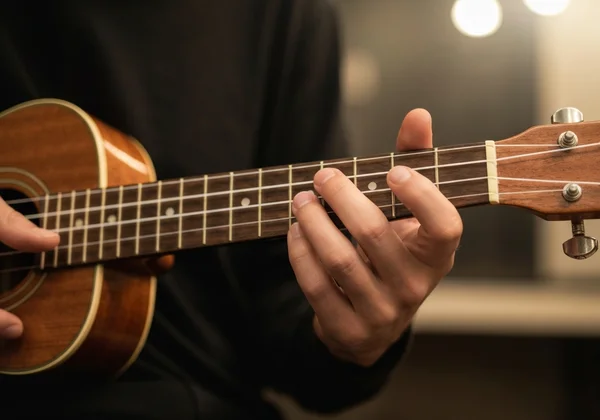Ukulele Tuner & Guide: Tune, Play Chords, & Maintain Your Uke
Tuning your ukulele accurately is the essential first step to making beautiful music. This guide is a comprehensive resource for ukulele players, helping you master tuning with our free online tool, unlock new chords, and maintain your instrument. How do I know if my ukulele is in tune? This guide will show you how our free online ukulele tuner makes tuning effortless, so you can say goodbye to guesswork and hello to harmonious playing.
The journey to mastering the ukulele begins with a single, perfectly tuned note. It’s the foundation upon which every chord and melody is built. With the right tool, this crucial first step can be simple, fast, and incredibly accurate. We’ve designed our accurate online tuner at Tuner.wiki to be that reliable partner for you, available anytime, anywhere, right in your browser. Let's dive in and get your ukulele sounding its absolute best.
Mastering Ukulele Tuning: Your Essential Guide
Before you can strum a single chord, your ukulele needs to be in tune. An out-of-tune instrument can make even the most skilled player sound off, which is especially frustrating for beginners who might blame themselves instead of the instrument. Tuning regularly trains your ear and builds a good habit that will serve you throughout your musical journey. It ensures that the notes you play are the correct pitch, allowing you to play along with songs and other musicians accurately.
Standard GCEA Tuning: The Foundation of Ukulele Play
The most common tuning for soprano, concert, and tenor ukuleles is standard GCEA tuning. This is often called "C tuning." When you look at the strings from top to bottom (closest to your chin to closest to the floor), they are tuned to the following notes:
- G (4th string): The string closest to the ceiling.
- C (3rd string): The next string down.
- E (2nd string): The second string from the floor.
- A (1st string): The string closest to the floor.
A fun way to remember this is the phrase, "My Dog Has Fleas," where each word corresponds to a string from top to bottom. This GCEA configuration gives the ukulele its bright, happy, and iconic sound. It's the tuning you'll need for the vast majority of ukulele songs and tutorials you'll find online.
Exploring Alternate Ukulele Tunings: Low G and Baritone
As you advance, you might want to explore alternate ukulele tunings to achieve a different sound. Two popular alternatives are Low G and Baritone tuning.
- Low G Tuning: This is the same as standard tuning, but the high G string is replaced with a G string that is an octave lower. This gives the ukulele a fuller, deeper sound and extends its note range, which is popular among fingerstyle players.
- Baritone Tuning: Baritone ukuleles, the largest of the common uke sizes, are typically tuned differently. Their standard tuning is D-G-B-E, which is identical to the top four strings of a guitar. This gives them a much deeper, more guitar-like tone.
The beauty of a chromatic tuner, like our free chromatic tuner, is its versatility. It isn't limited to just one tuning; it detects any note you play, making it easy to experiment with these alternate tunings accurately.
Step-by-Step Guide: Tuning Your Ukulele Online with Our Tool
Ready to get in tune? Using our free online ukulele tuner is as easy as it gets. There's nothing to download or install. Here’s how to tune your ukulele right now:
-
Visit the Website: Open your browser on any device—computer, tablet, or phone—and navigate to the Tuner.wiki homepage.
-
Allow Microphone Access: A pop-up will ask for permission to use your device's microphone. Click "Allow." This is essential so the tuner can hear the notes you play.
-
Pluck a String: Start with the top string, G. Pluck it clearly and let it ring out.
-
Read the Feedback: The tuner on your screen will immediately display the note it hears. A needle or indicator will show you if the note is "flat" (too low) or "sharp" (too high).
-
Adjust the Tuning Peg: If the note is flat, slowly tighten the corresponding tuning peg to raise the pitch. If it's sharp, slowly loosen it to lower the pitch. Make small adjustments.
-
Aim for Green: Continue to pluck and adjust the string until the tuner's indicator is perfectly centered and turns green, indicating the note is in tune.
-
Repeat for All Strings: Repeat the process for the C, E, and A strings. Once all four strings are green, you’re ready to play!

First Strums: Essential Ukulele Chords for Beginners
With your ukulele perfectly in tune, it’s time for the fun part: playing music! Chords are the building blocks of songs. By learning just a few basic shapes, you can unlock hundreds of popular tunes. A well-tuned uke ensures that these chords sound clear, resonant, and harmonious, just as they were intended.
Unlock Your First Songs: Basic Ukulele Chord Charts
Here are four of the most fundamental chords that every beginner should learn. They are often called "the magic four" because they are used together in countless songs.
- C Major (C): Place your ring finger on the 3rd fret of the bottom string (the A string). Let the other three strings ring open.
- G Major (G): Place your index finger on the 2nd fret of the C string, your middle finger on the 2nd fret of the A string, and your ring finger on the 3rd fret of the E string.
- A Minor (Am): This is one of the easiest! Just place your middle finger on the 2nd fret of the top string (the G string).
- F Major (F): Place your index finger on the 1st fret of the E string and your middle finger on the 2nd fret of the G string.
Practice switching between these shapes. It will feel awkward at first, but muscle memory will soon take over. Strum them with your instrument tuned using our ukulele tuner and listen to the beautiful harmony you can create.

The Harmony of Accuracy: Why Tuning Affects Chord Sound
Have you ever formed a chord perfectly, but it still sounded wrong? The culprit is almost always poor tuning. A chord is a combination of multiple notes played together. If even one of those notes is slightly flat or sharp, the entire chord will sound dissonant and unpleasant.
This is why precise tuning is non-negotiable. Using an accurate ukulele tuner like our chromatic tuner ensures that every string is at its exact target frequency. This precision allows the notes in your chords to vibrate in perfect harmony with each other, producing the rich, full sound you want to hear.
Ukulele Maintenance: Keep Your Uke In Tune & Playable Longer
Taking good care of your ukulele is essential for keeping it in tune and ensuring it lasts for years. Proper maintenance goes beyond just tuning before you play. It involves caring for the strings, understanding the instrument's structure, and protecting it from environmental damage.
How to Change Ukulele Strings for Optimal Sound
Ukulele strings don't last forever. Over time, they lose their brightness and ability to hold their pitch. You should change ukulele strings every few months, or sooner if you play frequently. New strings have a much clearer, louder tone.
When you put on a new set, they will need time to stretch and settle. For the first few days, you'll find yourself needing to tune them much more often. This is completely normal. Use the Tuner.wiki tool frequently during this break-in period to keep them at the correct pitch until they stabilize.
Quick Check: Basic Ukulele Intonation for Pitch Clarity
Intonation refers to how well an instrument stays in tune across the entire fretboard. Sometimes, a ukulele can be perfectly in tune on the open strings but sound out of tune when you play notes further up the neck. This is an intonation problem.
You can perform a basic ukulele intonation check easily. Use our online tuner to tune an open string perfectly. Then, press that same string down at the 12th fret and pluck it again. This note should be exactly one octave higher than the open string. If the tuner shows it's sharp or flat, your ukulele's intonation may need adjustment by a professional.
Environmental Factors: Protecting Your Ukulele's Tune
Your ukulele is made primarily of wood, which is sensitive to changes in temperature and humidity. Sudden shifts can cause the wood to expand or contract, which will throw your instrument out of tune and can even cause long-term damage like cracks or warping.
To protect your uke, try to store it in a case when not in use. Avoid leaving it in direct sunlight, in a hot car, or in a damp basement. Maintaining a stable environment is one of the best ways to ensure your ukulele stays in tune longer and remains a joy to play for years to come.

Ready to Play? Tune Up & Start Your Musical Adventure!
Proper tuning, practicing chords, and regular maintenance are the keys to sounding your best and growing as a musician. We built this free online tuner to be the most convenient and accurate tool to support you at every step. It’s always ready to help you find that perfect pitch, so don't let an out-of-tune ukulele hold you back. Visit our online tuner at Tuner.wiki to tune up and start playing with confidence.

Frequently Asked Questions About Ukulele Tuning & Care
Is an online ukulele tuner accurate?
Yes, absolutely. Modern online ukulele tuners use advanced algorithms to analyze the sound frequency picked up by your device's microphone. They are highly accurate and can be even more precise than some clip-on tuners, providing instant visual feedback to help you achieve perfect pitch quickly and easily.
What is the standard tuning for a ukulele?
The standard tuning for soprano, concert, and tenor ukuleles is G-C-E-A, often referred to as "Standard C" or "High G" tuning. The strings are numbered 4-3-2-1 from top to bottom (G4, C4, E4, A4). This is the most common configuration and the one you'll need for most songs and tutorials.
How often should I tune my ukulele?
You should tune your ukulele every single time you pick it up to play. Strings are sensitive to changes in temperature and humidity and will naturally drift out of tune. New strings require even more frequent tuning for the first week as they stretch. Making it a habit ensures you always sound your best.
Can I tune my ukulele with a phone?
Definitely! One of the biggest advantages of a browser-based tool is that it works on any device with a microphone and a web browser, including your phone. You can visit our free online tuner at Tuner.wiki on your smartphone to access a powerful, accurate tuner without needing to download a separate app, saving space and making it incredibly convenient.